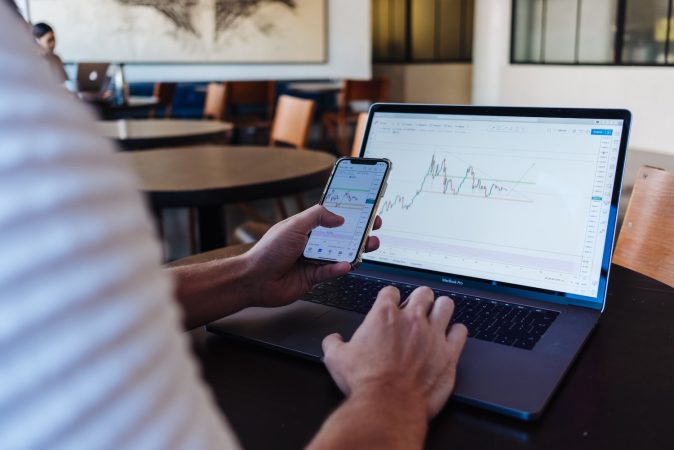“I’m not a finance expert.”
“I’m so afraid I will lose money on low-performing investments.”
“I want to get in on the growth, but I don’t know when it’s the right time to buy or sell.
Have any of these statements ever resonated with you? The prospect of putting your money to work in the market can be exciting, but the risk it carries can have you hesitant to invest at all.
Even big-name stocks can lose value suddenly and unexpectedly. Sandy invested in Disney, and ended up losing $7,3– in value (-41%) over the last year when the stock’s value plummeted.
If she had been using myRiskAlert, she could have minimized the loss by selling the stock when she received an alert to sell. Her downside would have been limited to $2,700.
Being Smart Helps, but it’s Not Everything
Markets are volatile by nature as stock prices constantly rise and fall. New information changes people’s expectations of the companies in which they are investing every day, meaning no one can accurately predict when to buy or sell.
Making sound investment decisions involves education, time, consistent monitoring, and vigilance, and even then – economists disagree every day about what is going on in the markets. Even if you have the time to monitor your stocks, being continuously glued to your phone is not financial freedom. MyRiskAlert does the monitoring for you and will notify an investor when their stock has hit a certain threshold of risk – both high and low.
Common Investment Safeguards
If you’re not a finance guru, that doesn’t mean you have to sit on the sidelines. These guidelines are a great place to start if you want to invest and insulate your money from risk.
Note: the following content does not constitute official investment advice. For specific insights into individual stocks, be sure to contact a professional financial advisor.
- Start Simple.
If people start talking about stocks, bonds, and different kinds of IRAs, do your eyes simply glaze over? You’re not alone.
Investing doesn’t have to be complicated. If you’re wanting to dip your toes into investing, start simply by choosing one or two investment vehicles and a small amount of money. ‘
- Diversify.
Perhaps one of the most basic elements of investing is diversification. What does that mean, exactly? Think of it this way: if you had a business, you wouldn’t rely on a single client. If they left, you’d lose it all. It’s the same with your investments – by putting all your “eggs in one basket” essentially, your risk goes up substantially.
Spreading investments across different asset classes is an insulation technique. If one market or stock goes south, you may be able to offset the decrease with an increase in other assets.
- Invest according to your goals.
Time is another critical factor in investing. Think in terms of how you plan for your money to be utilized.
Shorter Time = Lower Risk Tolerance
Longer Time = Higher Risk Tolerance
If you want to purchase a boat or a lake house in a year or two, you need a relatively low-risk investment. If, on the other hand, you’re investing for the long term, like retirement, you’ll be able to tolerate a bit of higher risk early on. The reason for this is that you’ll have a bit of extra time to wait for the market to rise again even if you suffer a loss.
Let us be clear: if time is on your side for your investments, you have less reason for concern. Compound interest has proven to be worth the risk time and time again.
- Do Not “Set it and Forget It”
Monitoring your investments is an essential part of investing at any level. It is absolutely necessary to pay attention to past trends and signals that may indicate changes on the horizon and make necessary adjustments.
But wait, I’m not an economist! I don’t know what past trends and signals you’re talking about!”
You don’t have to be. You don’t have to know. It’s 2022, and technology is available today that translates into actionable insights for your investments.
Use Technology to Make Better Investment Decisions
I did not have myRiskAlert and sold my Paypal shares after losing half its value. I still think this is a good long-term stock. When should I buy it back?
Yikes, Netflix stock just fell. It’s still falling. Too bad I didn’t see that one coming.
Statements like these translate to actual dollars lost or gained.
RiskAlert can let you know when there are buying opportunities and also help insulate you from risk in volatile and bear markets.
For example, let’s say you own 10 shares of Facebook stock (now traded as Meta Platforms Inc). You’d been enjoying a nice climb to the height of its value in September of 2021 at $380 a share.
Fast forward a few months to its plummet down to under $200 a share in March 2022.
If you had taken action on alerts from myRiskAlert, your 100 shares could have saved you around $7,000 in just one year using myRiskAlert as a management tool. If you sold on the first alert and didnot repurchase, you could have saved around $14,000.
RiskAlert allows you to establish risk percentages and opportunity percentages, giving you the capability to make decisions to sell high and buy low.
It’s never been easier to protect your investments – without the huge time commitment, stressful analysis, lack of confidence, and that economics degree.




